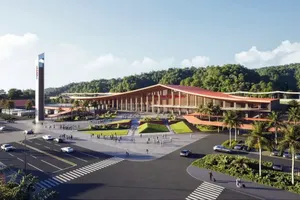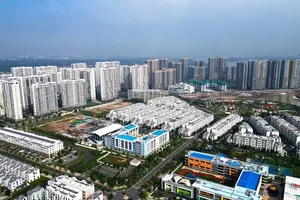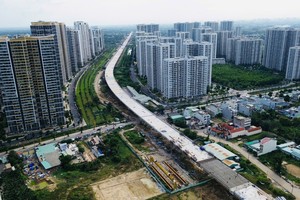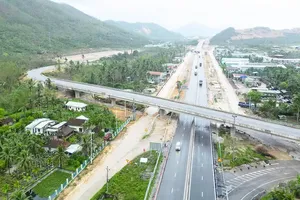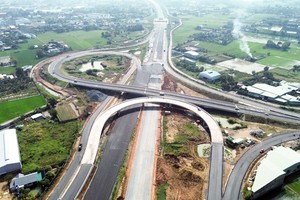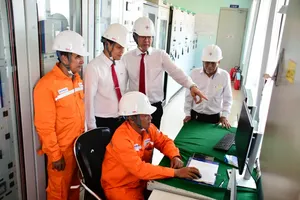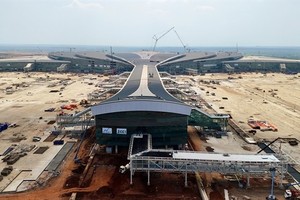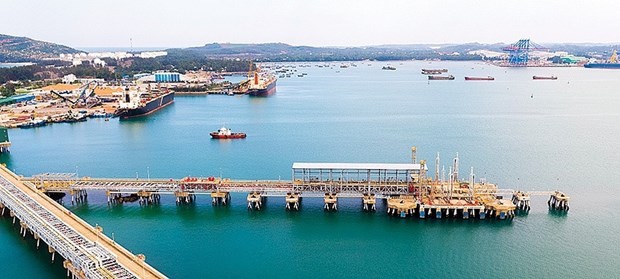 |
The terminal for transporting products of the Dung Quat oil refinary forms part of the port system in Dung Quat Bay. (Photo: petrotimes.vn) |
When a major oil and gas project is implemented, its host locality will benefit from better infrastructure because big and well-built roads are required for the transportation of giant equipment serving the construction. Operations of that project will also help fuel local economic development which will subsequently boost investment in transport infrastructure.
Binh Son district in central Quang Ngai province, which accommodates the Dung Quat refinery, has recorded strong improvements in not only road but also seaport and logistics infrastructure.
The seaport system in the Dung Quat Economic Zone currently has 45.3ha of warehouses and other storage spaces, the largest compared to other seaports in the central region.
Thanks to the wave resistant dyke that is 1.6km long and 10m higher than the sea level off the refinery, a vast area within Dung Quat Bay is not affected by sea waves, making it suitable for developing ports and logistics services.
Dung Quat Port is envisioned to become a general port which will attract goods from the Central Highlands to be transported through once the expansion of National Highway 24 is completed. In the near future, it will be turned into the biggest cargo port for handling coal, steel, petrol and oil in Vietnam.
In the plan to develop Vietnam’s seaport system by 2030 with a vision to 2030, Dung Quat Port will include terminals capable of handling vessels of 10,000 - 50,000 deadweight tonnes and container ships of up to 4,000 twenty-foot equivalent units (TEUs).
Five terminals for common use, invested by the Hao Hung One-Member Limited Liability Company, in the Dung Quat Economic Zone were completed in 2018 while 11 others for special use, part of the Hoa Phat Dung Quat cast iron and steel production complex project, in 2019. Another general terminal will be built soon to raise the capacity of the Dung Quat 1 port system to 22 million tonnes per year.
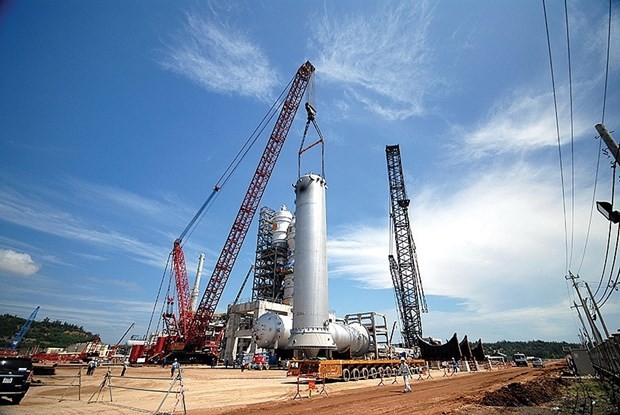 |
Big and well-built roads are required for the transportation of giant equipment serving the construction of major oil and gas projects. (Photo: petrotimes.vn) |
Before the Dung Quat refinery came into being, supporting industries in Quang Ngai were small and made just modest contributions to the province’s industrial value. However, since 2011, when the refinery became operational, supporting industries have been growing considerably and playing an increasingly important role in the local economy.
The Dung Quat refinery has created momentum for supporting industry projects in the fields of mechanical engineering, heavy industry, steel production, shipbuilding, petrochemistry, biofuel, textile - garment, leather - footwear, electronics, wood processing, and paper production.
Data from the General Statistics Office showed that the volume of cargo transported in the central region increased 8.73-fold in 21 years, from nearly 43.7 million tonnes in 2000 to over 381.1 million tonnes.
This refinery’s impact on the cargo transportation volume in the region could be seen in statistics recorded before, during, and after its construction. Before 2005, the volume of cargo transported in Quang Ngai accounted for just over 1% of the total across the central region. It gradually increased during 2006 - 2010 to make up more than 2%. The rate has topped 3% since the refinery was put into operation in 2011.
In addition, passenger transportation in the region has also been on the rise over the years, from 93.8 million passengers in 2000 to 120.1 million in 2005, 201.9 million in 2011, and a peak of 379.7 million in 2019. Quang Ngai in particular also saw an increase from 0.9 million passengers in 2004 to 1.1 million in 2005 and 2.3 million in 2011.
Between 2005 and 2010, the number of passengers transported across the central region doubled compared to previous years. Quang Ngai posted an annual growth rate of 5.77 percent in the passenger volume during the period. These figures reflected certain impacts of the construction of the Dung Quat refinery on passenger transportation in the province and the central region at large.
The building of the Dung Quat refinery has shown observable positive impacts on socio-economic aspects in the central region, demonstrating the Party and State’s clear-sighted decision to place the country’s first oil refinery here.

